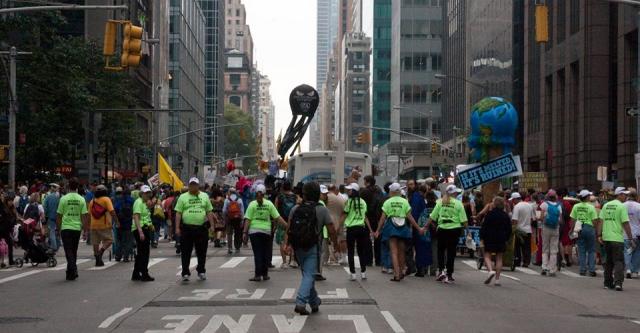






 Members of the group 350Madison attended the People's Climate March in New York City on Sept. 21 (Courtesy photo)
Members of the group 350Madison attended the People's Climate March in New York City on Sept. 21 (Courtesy photo)
Packed into three buses for an overnight journey, more than 150 Madisonians arrived in New York City on Sunday to participate in the People’s Climate March with about 400,000 fellow activists.
350Madison, a local climate action team, chartered the buses and organized a send-off event on Saturday for those participating in the march. Arriving late on Sunday, the contingent of environmental activists joined with others from across the country.
The People’s Climate March was organized by 350.org as a public show of support for the UN Secretary General Ban ki-Moon’s call for a meeting of the heads of state to discuss climate change.
“This is not just an environmental march, it’s about climate justice,” said Beth Esser, organizer for 350Madison. “We had people from age 3 to 70 who were all on board.”
350Madison’s main focus for the march was stopping the planned expansion of Enbridge Energy’s Pipeline 61. The pipeline runs tar sand from Alberta, Canada through Wisconsin, and the group believes the proposed expansion will increase the potential damage resulting from toxic spills, and promote the increase of fracking.
The Enbridge pipeline closely parallels the Keystone XL pipeline that has drawn recent political attention and environmental protest.
To raise awareness about the Pipeline issue, 350Madison contracted artists Carl Whiting and Paul Sieber to create a giant, inflatable Octopus to be carried above the Madison marchers. Emblazoned with “Embridge” across its side, the black tentacles and ominous features of the six-foot balloon characterized the effects that tar sand could have on Wisconsin’s environment. Esser said the balloon drew attention from a multitude of fellow activists, allowing 350Madison’s message to be heard.
“It was a way bigger turnout than the organizers anticipated,” Esser said. “The march took up 30 city blocks, and we waited three hours just to get to the march’s starting point.”
Across from Central Park, the activists from Madison marched for two hours alongside the other 1,500 climate groups through Manhattan. A jumbotron showcased footage of international protestors from the other 160 countries, including a large showing in London.
At 12:58 p.m. on Sunday, a two-minute moment of silence fell across the 400,000 participants to honor those whose lives have been already affected by climate change.
At exactly 1 p.m., a loud horn from the front of the march triggered the crowd to erupt with noise in order to “sound the alarm” on climate change.
350Madison hopes that for Wisconsin, it hasn’t sounded too late.
 Artists Carl Whiting and Paul Sieber created a six-foot tall inflatable octopus to illustrate what they believe the effects of the Enbridge Pipeline could be (Courtesy photo)
Artists Carl Whiting and Paul Sieber created a six-foot tall inflatable octopus to illustrate what they believe the effects of the Enbridge Pipeline could be (Courtesy photo)
|
|
|
Welcome to the Madison Commons, a website designed to provide news and information about all of Madison's neighborhoods and a crossroads for the discussion of community issues. The name comes from the idea of a village commons, a place for news, talk, debate, and some entertainment, too, that's open to everyone.
All rights reserved. Read more about the Madison Commons and its partners.

